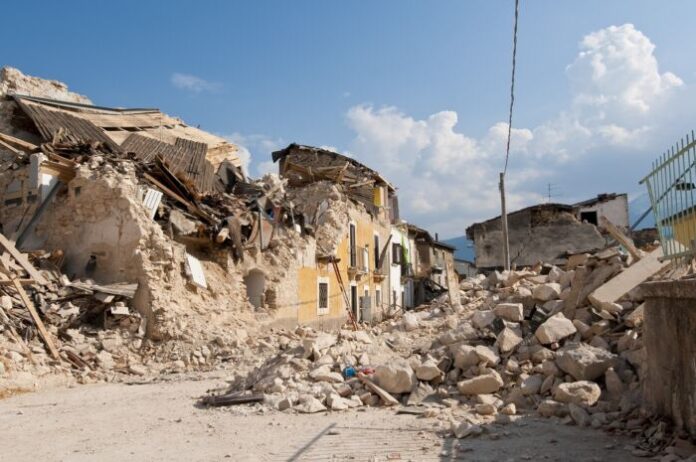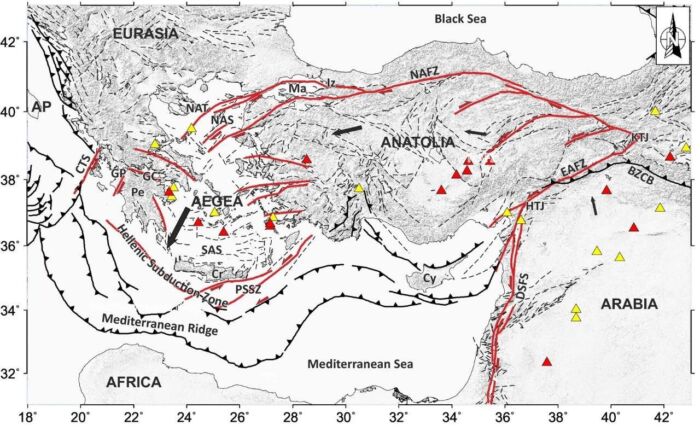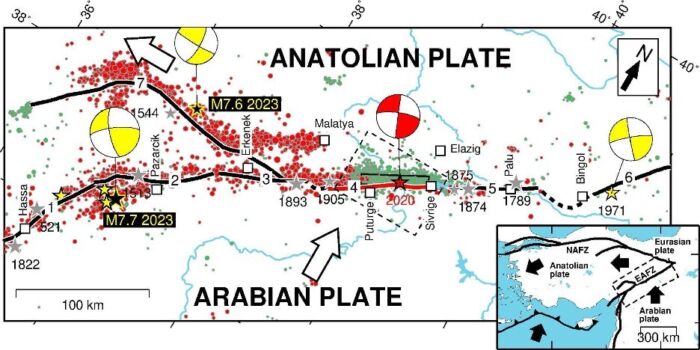
An earthquake with a magnitude of 7.9 was recorded in Turkey on 6 February 2023 and affected a large area in south-eastern Anatolia, on the border with Syria. This event was replicated about 9 hours later by another tremor with an estimated magnitude of 7.5, about 60/70 km north-east of the first one; in addition, there were numerous aftershocks with a magnitude greater than 4.5, outlining a catastrophic picture in terms of damage and the number of victims. In fact, the main events affected a vast area between southern Turkey and Syria, resulting in the total collapse of thousands of buildings and causing tens of thousands of casualties. The death toll stands at 57,700 and more than 264,000 buildings were destroyed.
From a geological and geodynamic point of view, the area affected by this seismic sequence falls along the margins of the Arabian and Eurasian plates (also known as the Anatolian plate); in particular, a segment of the East-Anatolian fault with left-trending kinematics of variable length between 600 and 700 km was activated, which together with the North-Anatolian Fault (over 1500 km long), represents one of the most seismically active structures in the Middle East. In addition, the second magnitude 7.5 event was located on a different fault segment, oriented E-W interconnected with the East-Anatolian fault, and the ongoing sequence recorded more than 200 aftershocks of magnitude greater than 5, each time worsening the picture of damage and/or possible victims buried under the rubble. From a geodynamic point of view, the Anatolian region has been affected by complex deformation processes since 35 million years ago, resulting in the extrusion towards the western quadrants of the so-called Anatolian block over the last 5 million years (Fig. 1).

This process results in historical seismicity that has already produced very strong earthquakes of comparable energy to that released in 2023, including the Elazig earthquake of 24 January 2020 (Fig. 2). This event occurred in an area where many authors have recognised important seismic gaps along the entire fault system, and in fact areas where historical seismicity shows apparent periods of seismic ‘calm’ are major candidates for the occurrence of future strong earthquakes. From these studies and from the comparison of seismological data of the 2023 earthquake sequence, it was possible to note that the latter (2023) is currently located at the southwestern margin of the fault system that generated the 2020 seismic crisis and that, therefore, there may be a sort of interconnection between the events in terms of temporal succession. In fact, it is well known that strong earthquakes cause changes in the state of stress on active faults located near the epicentre and/or at the margins of the tectonic structures responsible for the earthquake itself; in some cases this causes a tectonic stress surplus on adjacent faults that accelerates future seismic rupture.

In other words, the recurrence time of significant events is shortened, as strong earthquakes can further ‘load’ nearby structures, which are often also characterised by a seismic gap. Such behaviour would seem to be true for the Turkish case, as well as for other examples such as Amatrice and Norcia 2016 in Italy. In fact, recent studies have shown that the 2023 earthquake in Turkey was the largest recorded in the last 2000 years, with a twofold series of very strong, closely-spaced tremors that are considered to be the most powerful ever experienced on land.
In terms of the effects of the earthquake, very extensive damage was recorded, resulting in a high number of casualties for two main reasons: the intensity of the seismic shocks and the relatively poor resilience of the buildings. Every structure subjected to seismic tremors experiences predominantly horizontal ground accelerations, and the published data show that the intensity of the event on buildings was very strong. Furthermore, it is easy to see from the widely broadcast images that a large number of buildings suffered very significant structural damage and partial or total collapse. These reinforced concrete structures (very similar to the residential buildings constructed in Italy) collapsed mainly due to structural crises in the lower floors, synonymous with an inadequate and/or total lack of adequate anti-seismic design criteria.
In addition, since earthquakes of this intensity are characterised by a high number of aftershocks with large magnitudes (above 4.5 on the Richter scale), buildings already damaged by the main shocks would have suffered further damage, amplifying the observed damage. This effect depends on the structure’s previous state of damage, which is minimised if the building complies with earthquake-resistant design criteria.
This makes it clear that such rules are essential for two main reasons: to avoid the collapse of buildings, which leads to a high number of casualties, and to drastically reduce the economic effects of the extensive damage. The latest estimates, in fact, are in the region of 100 billion dollars and do not include the costs of removing and disposing of rubble, posing a major problem both in terms of the economic sustainability of such catastrophic events, and in terms of the environmental sustainability of how to properly dispose of/recycle building materials reduced to rubble.



































